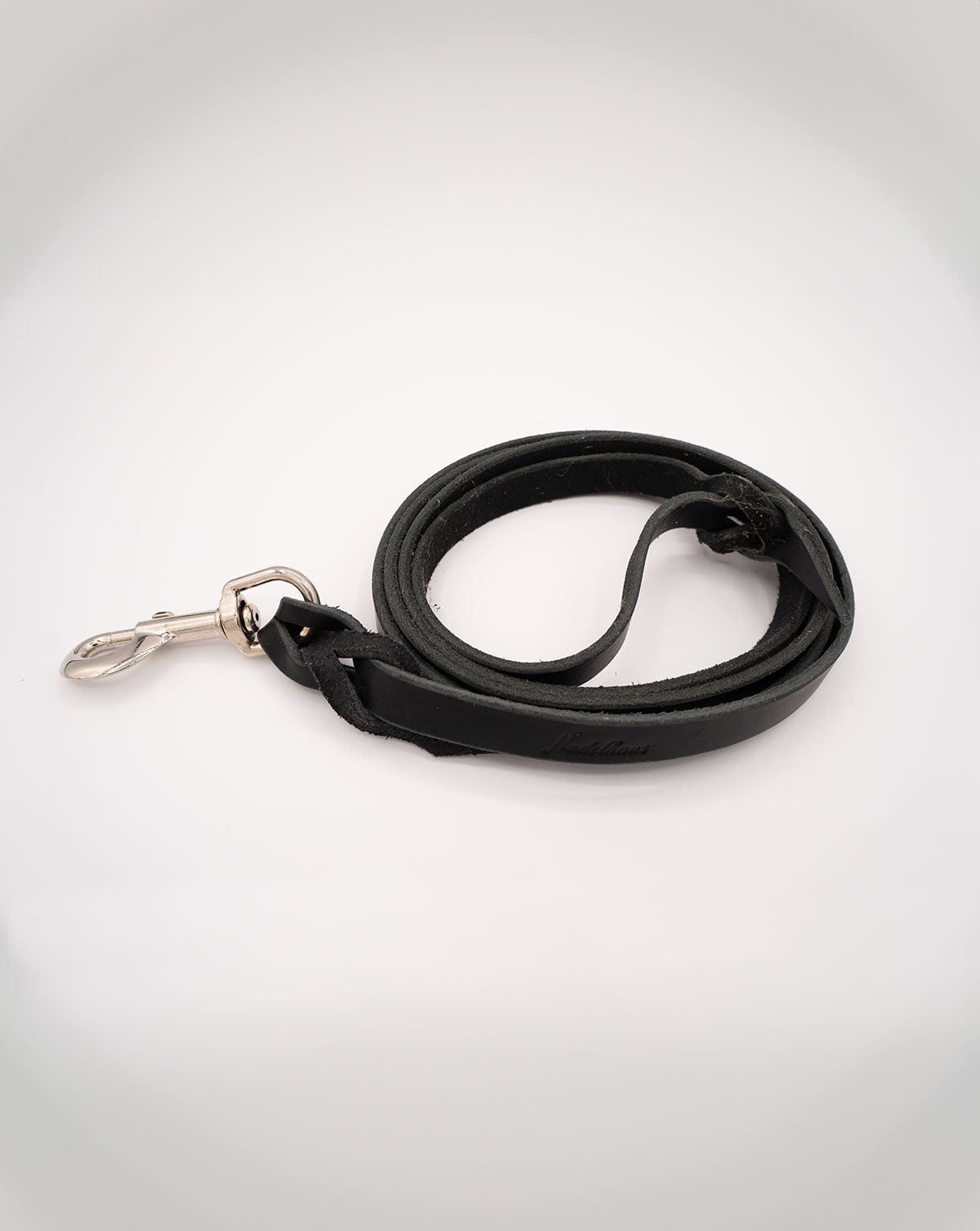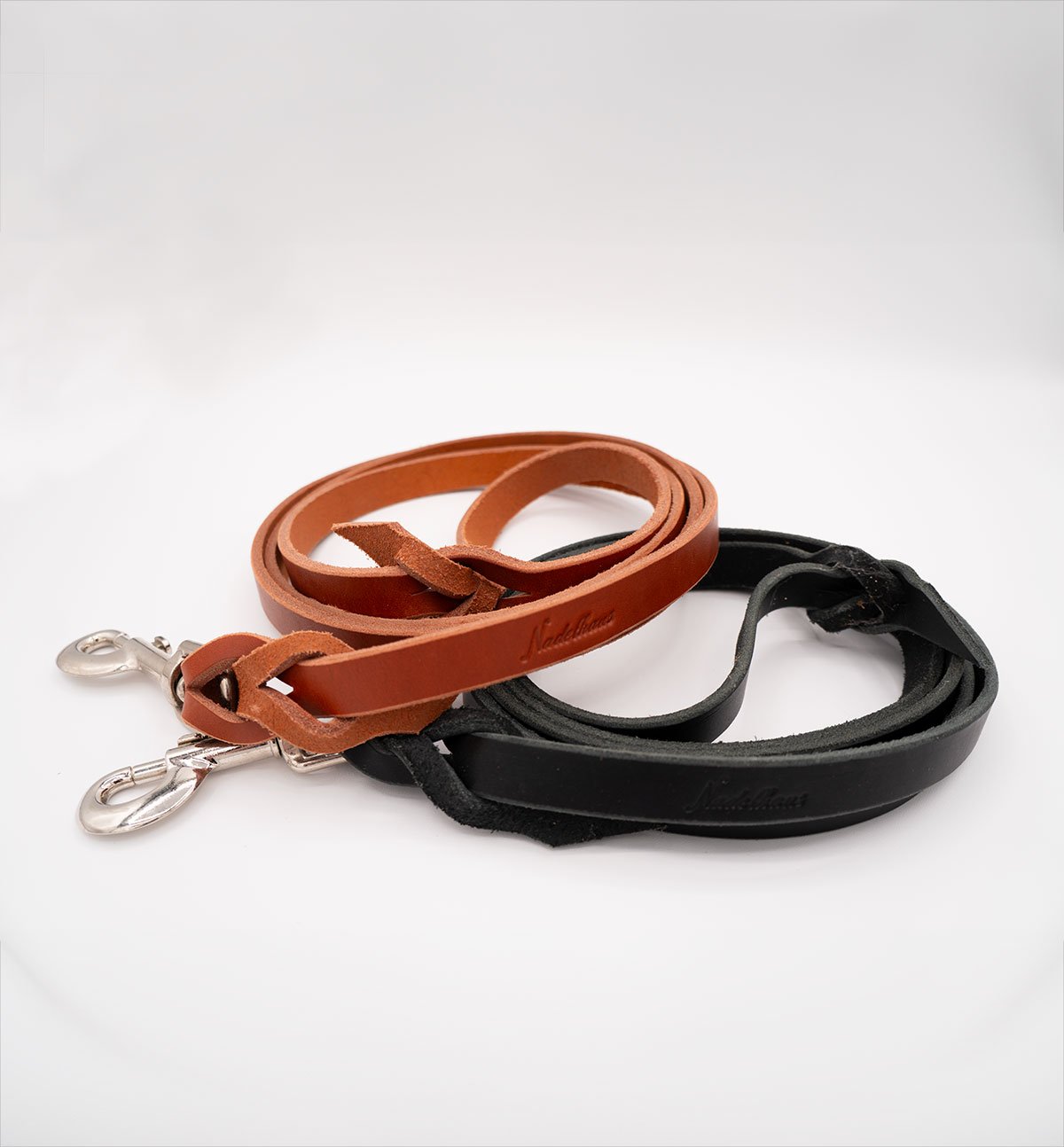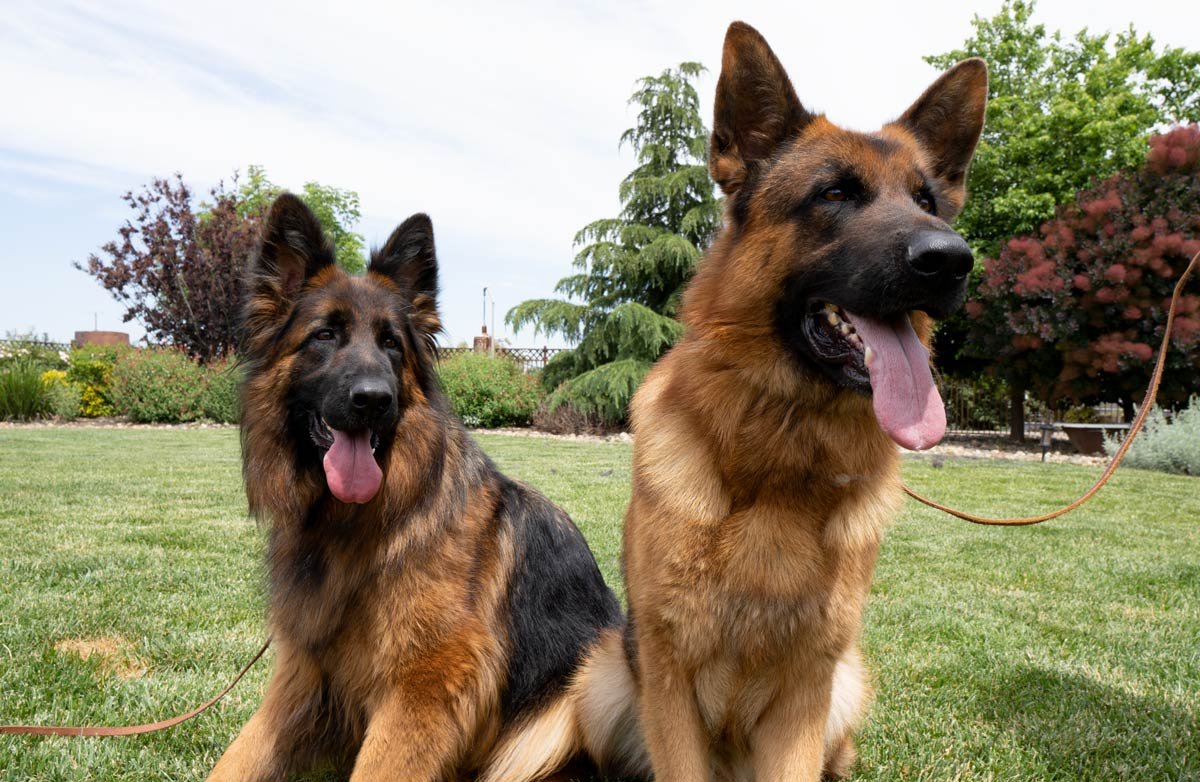
ALL ABOUT PRONG COLLARS FOR GERMAN SHEPHERD DOGS
OUR COMPREHENSIVE GUIDE
By Traci Needles, Owner of Nadelhaus German Shepherds
Updated October 14, 2023
What are prong collars?
Prong collars, also referred to as pinch collars, are a type of dog training collar that is made of metal links that incorporate prongs designed to gently pinch the dog's neck upon applying tension. The primary objective behind the use of prong collars in dog training is to provide a correction or aversive stimulus to deter unwanted behaviors and improve obedience during training. Advocates of prong collars argue that they can be particularly effective in managing and controlling robust, large, or excessively energetic dogs that may pose challenges when employing other collar types.
What are prong collars used for?
Prong collars play a vital role in establishing boundaries within dog training, and the following are a few reasons why prong collars are used:
Dog control and correction
Prong collars are thoughtfully engineered with inward-facing metal prongs situated around the upper neck region of the dog. These prongs gently exert pressure when tension is applied to the leash, simulating the corrective bite that a mother dog would naturally administer. When used appropriately and in conjunction with proper training techniques, prong collars facilitate clear communication and aid in setting boundaries for the dog.
Training aid for strong dogs
Prong collars can prove invaluable for owners with large dog breeds that may present difficulties in control due to their size or strength. The collar's design facilitates effective communication and reinforces training commands, making it more manageable for owners to train and handle powerful dogs such as German Shepherds.
Safety in dog training
When prong collars are used correctly and appropriately fitted, they offer a safer alternative to other devices such as choke chains. The even distribution of pressure across the collar reduces the risk of neck injuries to the dog, unlike sudden jerks or continuous pressure associated with other collar types.
Focus and engagement with your german shepherd
By providing immediate feedback and guidance, prong collars assist in redirecting a dog's focus and attention back to its owner. This improved focus leads to more productive training sessions and aids in the teaching of desired behaviors.
Temporary training tool for dogs
Prong collars are commonly employed as a training aid during the initial stages of obedience training or when additional control is necessary for specific activities. The objective is to utilize the collar temporarily to discourage unwanted behaviors while concurrently implementing positive reinforcement techniques to instill appropriate manners. It is important to note that prong collars should not be used as a permanent solution, but rather as a means to shape behavior and transition to training methods centered around positive reinforcement.
VIDEO: Learn why Nadelhaus German Shepherds uses prong collars for obedience training. (1:09 min)
Are prong collars dangerous or bad for GERMAN SHEPHERD dogs?
While prong collars can be responsibly and effectively utilized by knowledgeable dog owners or trainers, it is crucial to acknowledge that improper or excessive use of prong collars can potentially result in harm or discomfort for German Shepherds or any types of dogs. Therefore, the utilization of prong collars should be approached with caution and responsible handling.
Here are some ways in which prong collars can be used in an unsafe way for dogs:
Improper sizing and fitting of the prong
When a prong collar is not correctly fitted to the dog's neck, it can inflict pain, discomfort, or injury. A collar that is excessively tight may cause choking or damage to the dog's trachea, while a collar that is too loose may fail to deliver the desired corrective effect adequately.
Excessive force or jerking with the prong collar
Some individuals may misuse pinch collars by exerting excessive force or employing sharp jerking motions on the leash. This can result in severe pain, distress, and potential physical harm to the dog.
Prolonged or unnecessary use
Prong collars should only be used for training purposes and not left on the dog unattended or employed as a permanent collar. Prolonged and uninterrupted use without breaks can lead to discomfort and potentially cause skin irritation or injuries.
Lack of positive reinforcement in dog training
Solely relying on prong collars for training without incorporating positive reinforcement techniques can create negative associations between the collar and the desired behaviors. This may result in the dog experiencing fear, anxiety, and reluctance to engage in training.
Inadequate understanding of dog training
Improper use of prong collars often stems from dog owners or trainers who lack the necessary experience or knowledge of correct dog training techniques. It is imperative to acquire proper education, seek guidance from professional trainers, and understand the specific needs of the dog to ensure their well-being and welfare. Emphasizing positive reinforcement techniques and training methods based on rewards should always remain the primary focus in dog training.
What size prong collar should I buy for my GERMAN SHEPHERD dog?
At Nadelhaus German Shepherds, we recommend Herm Sprenger prong collars. Choosing the right size for your dog will depend on two things: your dog’s weight and your dog’s neck size.
Your dog’s weight determines the wire gauge of the prong.
Up to 40 lbs (max of 66 lbs) = 2.25 mm
Up to 77 lbs = 3 mm
Up to 88 lbs = 3.25 mm
Up to 154 lbs = 4 mm
Your dog’s neck size determines the length of the prong.
Measure your dog’s neck and add 2 inches. (For example, if your dog’s neck is 14” wide, you prong collar will need to be at least 16”.)
Please note that Nadelhaus does not recommend the 4mm prong size for our German Shepherds. The max size you should buy for one of our German Shepherds is the 3.25mm prong.
Image: Here we show the correct prong position on an adult German Shepherd. The blue line shows the incorrect position of prong collar placement.
How to properly fit a prong collar on your GERMAN SHEPHERD
Select the appropriate prong collar size: Prong collars are available in various sizes, typically based on the circumference of the dog's neck. Use a flexible measuring tape to measure your dog's neck and determine the right size. The prong collar should fit snugly, neither too tight nor too loose.
Prepare the prong collar: Before fitting the prong collar, remove any extra links that may be unnecessary for your dog's neck size. Most prong collars have detachable links that can be added or removed to adjust the length.
Placing the prong collar: Gently encircle your dog's neck with the prong collar, ensuring that the prongs face inward toward the fur. It's important to note that you should not attempt to slide the collar over the dog's head, as it will not fit properly. Instead, detach one prong end from another, place the collar around the dog's neck, and reattach the two prong ends. Position the collar high on the neck, just behind the ears and under the jawline. The collar should fit snugly, allowing you to insert a finger or two between the collar and the dog's skin.
Securing the prong collar: Connect the ends of the prong collar by inserting the open end of the last link into the securing loop or ring on the opposite end. Ensure that it is securely fastened but not overly tight.
VIDEO: How to place a prong collar on your dog’s neck. (0:22 min)
What to do if your prong collar is too long or too short for your dog’s upper neck?
You can size a prong collar up or down by adding or removing prong links. If you have an older prong collar and are unsure of the actual wire gauge of the prong, these are the Herm Sprenger guidelines to know what size your prongs are:
2.25mm wire gauge = 1 inch long
3.2mm wire gauge = 1.5 inches long
4mm wire gauge = 2 inches long
VIDEO: How to lengthen or shorten your prong collar by adding or removing prong links. (1:11 min)
Where to attach the leash on the prong collar
Once the prong collar is correctly positioned on your dog's neck, attach the leash to the designated ring on the collar.
Prong collars generally have two rings: the live ring and the dead ring.
Live Ring vs. Dead Ring ON A PRONG COLLAR
There are two options for attaching the leash to the prong collar:
Live ring: The live ring is the outermost ring of the prong collar, located opposite to the prong links. It moves freely, allowing for more immediate correction when the leash is pulled. Attaching the leash to the live ring provides a higher level of direct pressure.
Dead ring: The dead ring is the inner ring of the prong collar, closer to the prongs. It has less mobility compared to the live ring. Attaching the leash to the dead ring provides a lower level of correction compared to the live ring. This can be beneficial for dogs that may be more sensitive or require less correction during training.
How to give your GERMAN SHEPHERD a correction with a prong collar
When using a prong collar, it is essential to approach corrections with care and precision to ensure the safety and well-being of your dog. Here is a general guideline for applying a correction with a prong collar:
Remain calm and composed: Corrections on your dog should be delivered calmly and assertively. It is crucial to maintain composure and avoid reacting out of frustration or anger.
Make a swift, controlled tug: Instead of forcefully yanking or jerking the leash, provide a quick and controlled tug. The objective is to interrupt the undesirable behavior or redirect your dog's attention, rather than causing pain or discomfort.
Apply directional pressure: Corrections should involve applying slight pressure in the direction opposite to the unwanted behavior. For instance, if your dog is pulling on the leash, give a quick tug to the side or slightly upwards to encourage them to return to your side.
Release the pressure: Once your dog responds and adjusts their behavior, promptly release the pressure to provide feedback and reinforcement for the desired response.
Follow up with positive reinforcement: After the correction, praise and reward your dog for exhibiting the correct behavior. Positive reinforcement, such as treats, verbal praise, or petting, helps to reinforce the desired response and strengthens the learning process.
It is important to note that corrections should be used sparingly and as part of a comprehensive training approach that emphasizes positive reinforcement and clear communication.
VIDEO: How to give a correction with a prong collar, demonstrated on a German Shepherd. (0:25 min)
At what age can you introduce a prong collar to puppies?
You can begin using a prong collar on puppies that are between four to six months old. However, the same precautions that apply to adult dogs should be taken into consideration:
Ensure the prong collar is sized and fitted correctly for the puppy's size.
Avoid misuse or overuse of the prong collar, especially with younger dogs.
Refrain from excessive jerking or applying excessive force with the prong collar.
Educate yourself on the proper usage of a prong collar and seek guidance from professional dog trainers if you are new to training with this type of collar.
prong collars vs. choke chains: are choke chains safe for dogs?
At Nadelhaus, we believe in providing safe and humane training tools for your dog. That's why we want to shed light on the difference between prong collars and choke chains, and why we advocate for the use of prong collars as our only training option.
Why we do not recommend choke chains for dogs:
Increased risk of injury WITH CHOKE CHAINS
Choke chains pose a higher risk of neck injuries, including tracheal damage or fractures, due to the intense pressure they exert on a dog's neck. Choke chains can cause damage to a dog's neck, including bruising, lacerations, and tracheal injuries, due to the constant pressure and constriction they apply.
Improper or excessive use
Improper use of choke chains, such as excessive force or jerking motions, can lead to neck and spinal injuries, as well as behavioral issues stemming from fear or anxiety associated with the collar.
Lack of control and communication
Choke chains provide limited control and hinder clear communication with your dog, making it difficult to effectively convey commands or redirect unwanted behaviors.
Prong collars offer a safer alternative to choke chains as they distribute pressure more evenly across the dog's neck, reducing the risk of injury. Unlike choke chains that constrict and apply constant pressure, prong collars provide clearer communication and control through gentle pressure points that mimic natural corrective bites. This allows for more effective training while minimizing the potential harm and discomfort associated with choke chains.
What are the best leashes to use when training german shepherds?
It is important to use a sturdy leash and ensure that it is properly attached to prevent accidental detachment. Nadelhaus always recommends leather leashes when training our German Shepherd dogs.
Reduced risk of leash burn
Certain materials, such as synthetic fabrics or nylon, may cause friction or leash burn when abruptly or forcefully pulled. Conversely, leather leashes tend to glide smoothly through the hands, preventing irritation or harm to the handler's skin.
Durability
Leather dog leashes are renowned for their durability and strength, making them a reliable option when handling robust and energetic German Shepherds. They are less prone to fraying or breaking compared to leashes crafted from other materials, ensuring enhanced security during training sessions.
Comfortable grip AND EASY HANDLING
Leather leashes provide a comfortable hold for the handler and reduces the chances of discomfort or blisters during long walks or training sessions.
Control and responsiveness
Leather leashes deliver excellent control and responsiveness, enabling handlers to effectively communicate with their dogs. The innate weight and flexibility of leather facilitate the delivery of subtle cues and adjustments, resulting in improved coordination and cooperation between the handler and the dog.
leather pull tabs for quick control of your german shepherd
Introducing our custom made, 6" leather pull tabs, a reliable quick control solution for dog owners. Crafted with premium quality leather, these pull tabs offer effortless control and comfortable handling during training, off-leash scenarios, and at home. Enjoy quick access and reliable restraint with confidence. These are a must when training a larger dog such as a German Shepherd.
BENEFITS OF A LEATHER PULL TAB FOR DOGS:
Quick and convenient access to your German Shepherd
A 6" leather pull tab provides a compact and lightweight option for managing your dog around the house. Its shorter length allows for easy attachment to your dog or puppy’s collar, ensuring quick access and control whenever needed. Whether it's guiding your dog through doorways, maneuvering around furniture, or quickly redirecting their attention, the pull tab offers a practical and efficient solution for maintaining control in indoor environments.
Efficient control for multiple dogs in your home
With our leather pull tabs, managing multiple dogs in your home becomes simpler. Gain quick and reliable control over each dog, allowing you to handle them effectively and ensure their safety and well-being.
Off-leash dog training aid
Our leather pull tabs are an excellent tool for off-leash training with your dog. Keep them close and maintain control while allowing them the freedom to explore and enjoy their surroundings. The convenient length of the pull tab provides a secure grip, enabling quick and easy guidance during training sessions.
Nadelhaus German Shepherds does not recommend leaving leather pull tabs on your dog when they are unsupervised, especially with younger dogs and puppies.
SHOP PRONG collars AND LEASHES
Nadelhaus German Shepherds offers Herm Sprenger prong collars as well as authentic leather leashes.
ABOUT THE AUTHOR
Traci Needles is the founder and owner of Nadelhaus German Shepherds™. Traci has been breeding German Shepherds since 1996. With nearly 30 years of experience with German Shepherds, she has extensive knowledge about this incredible working dog breed. Her mission is to breed German Shepherd dogs that have the ability to obtain Schutzhund titles and the highest possible conformation ratings. The German Shepherds she breeds are from 100% German bloodlines and Nadelhaus is a member of the GSDCA-WDA and SV of Germany.
LEARN ALL ABOUT GERMAN SHEPHERD PUPPIES AND DOGS



















